|

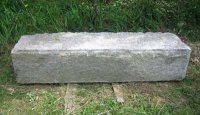 Granite mining and granite
Granite mining and granite
block similar to that use in
Training Center foundation
|
By: Frank Maguire
A complete tour of our Training Center should include a look at the
cellar of the barn, where you will see that the foundation consists of
large pieces of cut granite; one of them extending under the side entrance
is said to be sixty feet long. Where did the builders get such pieces of
stone? If you walk out behind the buildings and orient yourself in
a northeasterly direction, facing Nubble Ledge, then walk a beeline for
about a quarter mile you might come upon a jumble of giant boulders, remnants
of the last glacier to pass this way. Look among these rocks and
you might see that some of them bear the marks of chisel and drill, and
that some of them even hold rusted iron rods, left there when the builders
quit splitting the rock well over one hundred years ago. These are
the source of the foundation, as well as the “fence” around the Raymond
cemetery just down the road. Imagine moving such monster rocks with
nothing but manpower and oxen. |
| When the Camp Hinds property was purchased around 1926 the sale did
not include the property on the north side of Plains Road, including the
buildings associated with the Berry farm. That land and structures
remained in the hands of the Berry family, who conducted a summer business
there called “Justanold House”, a rooming house for summer visitors who
went swimming and boating at Crescent Lake.
After about twenty years the Pine Tree Council began to make plans for
a year-round program at Camp Hinds, and saw that the Berry farm buildings
and their six acres of land could be developed as a training center and
a positive addition to the summer camp. Negotiation resulted in an
agreement to purchase that property for $7000, of which the council had
raised $2000. The balance was received as a gift from the Portland
Rotary Club, whose name was enshrined on the new Center. |
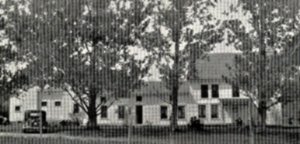 Training Center before renovations
Training Center before renovations
|
 Front of Training Center before
Front of Training Center before
renovations
|
Work began soon after to improve the buildings, Fred Foster was hired
as the permanent Camp Ranger, and the farm house became the living quarters
for Fred and his wife, Doris. Fred spent most of the following five
years working on that property and supervising staff members and volunteers
in remodeling the ell and barn.
The barn needed a major restoration, which included structural work,
paneling both the Memorial Room and the training room, wide oak floors,
the construction of the massive double fireplace in the center (financed
in part by donations from many Boy Scout troops) and the remodeling of
the large back half of the double barn into a training area downstairs
and a double deck of sleeping lofts upstairs. |
| Around 1949, when the fireplaces were being built, a staff man drove
his tractor into the front barn hauling a load of stones. Then he was shocked
to feel the floor cave in under him, dropping the stones and tractor into
the cellar! No one was hurt.
By 1951 the ell connecting the house and barn was completely removed
and replaced with the new kitchen and dining rooms much as they are today.
Bathrooms were added to this addition and the cellar area was paved with
asphalt, replacing the original dirt floor. It’s still dirt under the kitchen/dining
section.
The original triple bunks in the Training Center were gifts of the US
Navy, probably removed from troop ships after WW II. The furniture
for the training room was all made by the Pinelyne Company in Windham. |
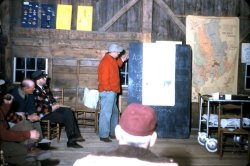 Training Room before renovations
Training Room before renovations
|
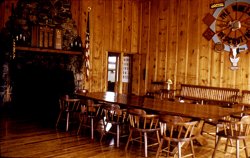 Memorial Room after removations
Memorial Room after removations
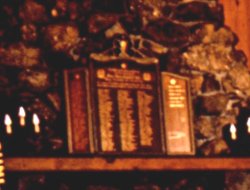
Memorial Plaque
|
The Memorial theme was completed with the placing of plaques over the
front fireplace commemorating the names of 105 former Scouts and Scouters
who gave their lives in WW II. That’s why it is called the “Memorial
Room.” The troops which donated to the fireplace project were to be commemorated
with a plaque above the back fireplace.
Improvements have been made over the years including a major upgrade
in fire safety in the mid-seventies when Ralph Lawrence, a retired contractor,
led volunteers in building two new enclosed stairwells, a back door to
the training room, updated wiring and improved bathroom facilities.
Remodeling the Training Center drove him crazy, because nothing was plumb
or level to begin with.
The bathrooms were updated again and a handicap ramp added in the late
nineties, the kitchen was upgraded and new heat-saving windows were installed
throughout the building.
One other note: the small garage next to the Training Center was originally
a staff cabin in camp located near the dining hall. It was jacked
up and rolled by truck to its present site to house the camp truck and
shelter the well which was under that building.. Look carefully on the
interior walls and you can still see the names of some of the staff members
who once slept there!
|
|
